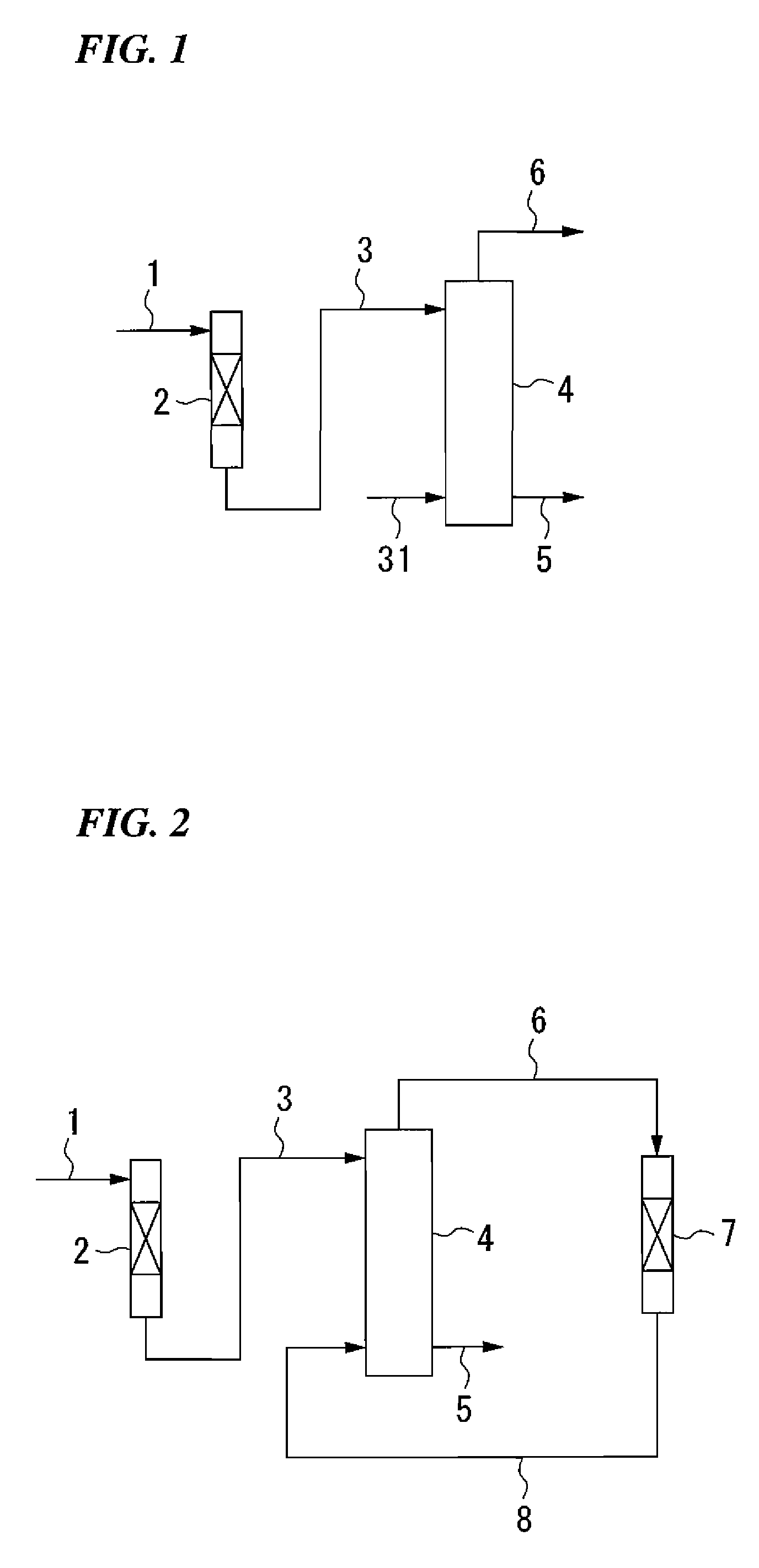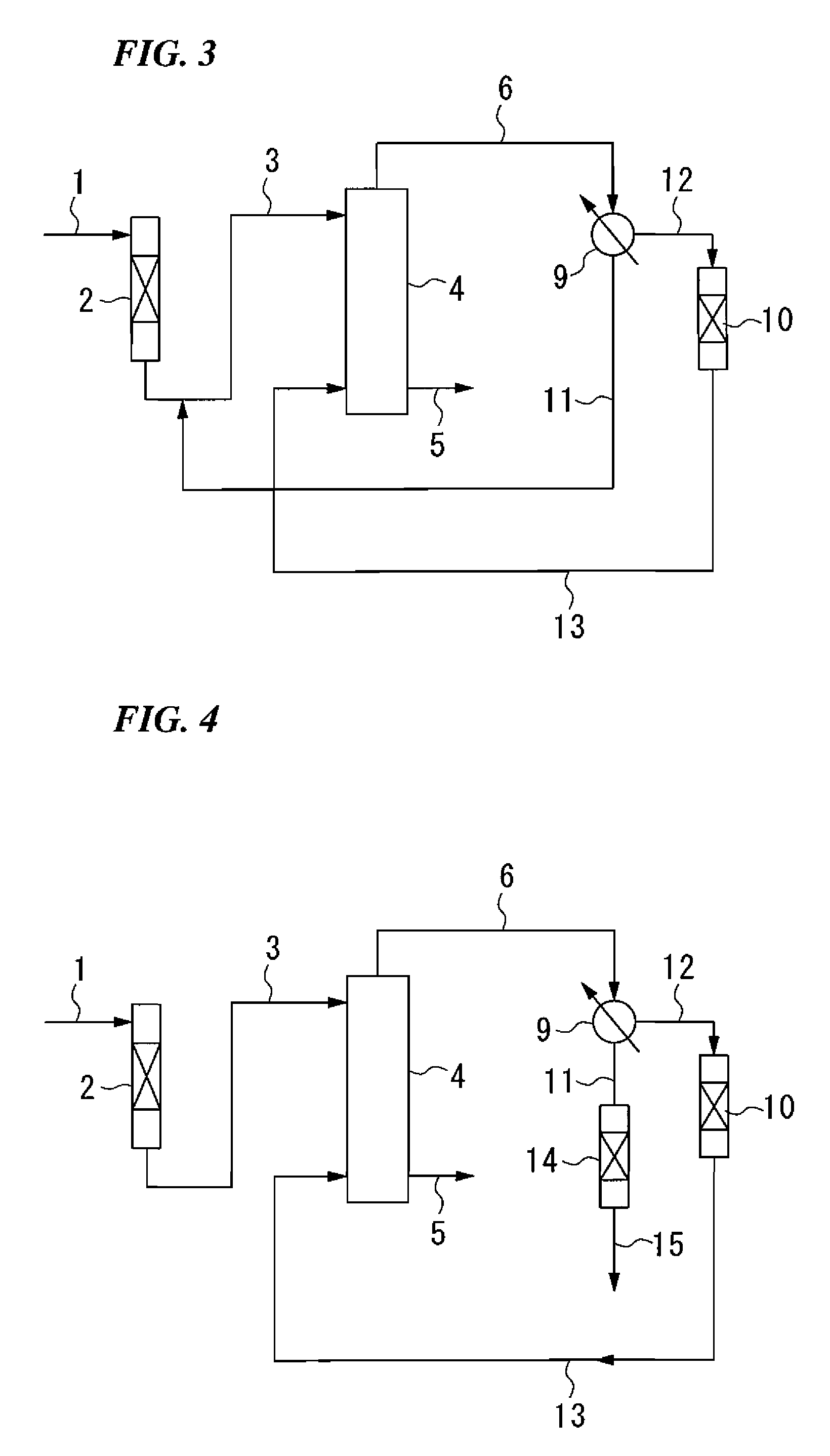Mercury removal apparatus for liquid hydrocarbon
a technology of liquid hydrocarbon and mercury, which is applied in the direction of tar working up by chemical refining, separation processes, physical/chemical process catalysts, etc., can solve the problems of increased costs and difficulty in adsorption process
- Summary
- Abstract
- Description
- Claims
- Application Information
AI Technical Summary
Benefits of technology
Problems solved by technology
Method used
Image
Examples
example 1
[0103]By using the apparatus represented by FIG. 3, the mercury component in a natural gas condensate (Erawan-condensate) which becomes the raw liquid hydrocarbon was removed.
[0104]In the natural gas condensate, the elemental mercury and the ionic mercury were contained at 520 wtppb and 140 wtppb, respectively.
[0105]As the conversion device 2, a reaction column formed of a stainless steel pipe (JIS Standard: SUS304) with a pipe diameter of 1 inch was used, and as the catalyst, MR-14 produced by JGC Corporation was used. The reaction conditions were as follows: a temperature of 200° C., a pressure of 0.6 MPa·G, and a retention time of the raw liquid hydrocarbon of 25 min.
[0106]As the first stripping device 4, a packed column was used. This packed column includes a column with a diameter of 1 inch and a length of 250 mm, which was filled with a Goodloe (registered trademark) packing as a filler to reach a filling height of 200 mm. A Goodloe (registered trademark) packing is a type of ...
example 2
[0114]By using the apparatus represented by FIG. 4, the mercury in the raw liquid hydrocarbon was removed.
[0115]As a raw liquid hydrocarbon, the natural gas condensate used in Example 1 was used.
[0116]Also, as the conversion device 2, the first stripping device 4, the first gas-liquid separation device 9, and the second adsorption device 10, the same as those used in Example 1 were used, and each operation condition thereof was the same.
[0117]As the third adsorption device 14, an adsorption column was used. This adsorption column includes a column formed of a stainless steel pipe (JIS Standard: SUS304) with an inside diameter of 20 mm and a length of 400 mm, which was filled with MR-3 produced by JGC Corporation as an adsorbent to reach a filling height of 250 mm.
[0118]The adsorption conditions of the third adsorption device 14 were as follows: a temperature of 40° C., a pressure of 0.5 MPa·G, and a liquid linear velocity of 0.5 cm / sec.
[0119]As a result, the second liquid hydrocarbo...
example 3
[0120]By using the apparatus represented by FIG. 8, the mercury in the raw liquid hydrocarbon was removed.
[0121]As a raw liquid hydrocarbon, a natural gas condensate was used, in which the elemental mercury content was 2,140 wtppb and the ionic mercury content was 300 wtppb.
[0122]As the second stripping device 16 and the first stripping device 4, a packed column was used.
[0123]This packed column includes a column with a diameter of 1 inch and a length of 250 mm, which was filled with a Goodloe (registered trademark) packing as a filler to reach a filling height of 200 mm.
[0124]The stripping conditions were as follows: a temperature of 100° C., a pressure of 0.05 MPa·G, a feed rate of the first liquid hydrocarbon of 2,000 kg / m2·hr, a feed rate of the first stripping gas of 3,660 kg / m2·hr, a gas / liquid flow ratio in the first stripping device 4 of 1.83 kg-G / kg-L, a feed rate of the raw liquid hydrocarbon of 2,100 kg / m2·hr, a feed rate of the second stripping gas of 3,900 kg / m2·hr, and...
PUM
| Property | Measurement | Unit |
|---|---|---|
| Concentration | aaaaa | aaaaa |
Abstract
Description
Claims
Application Information
 Login to View More
Login to View More - R&D
- Intellectual Property
- Life Sciences
- Materials
- Tech Scout
- Unparalleled Data Quality
- Higher Quality Content
- 60% Fewer Hallucinations
Browse by: Latest US Patents, China's latest patents, Technical Efficacy Thesaurus, Application Domain, Technology Topic, Popular Technical Reports.
© 2025 PatSnap. All rights reserved.Legal|Privacy policy|Modern Slavery Act Transparency Statement|Sitemap|About US| Contact US: help@patsnap.com



